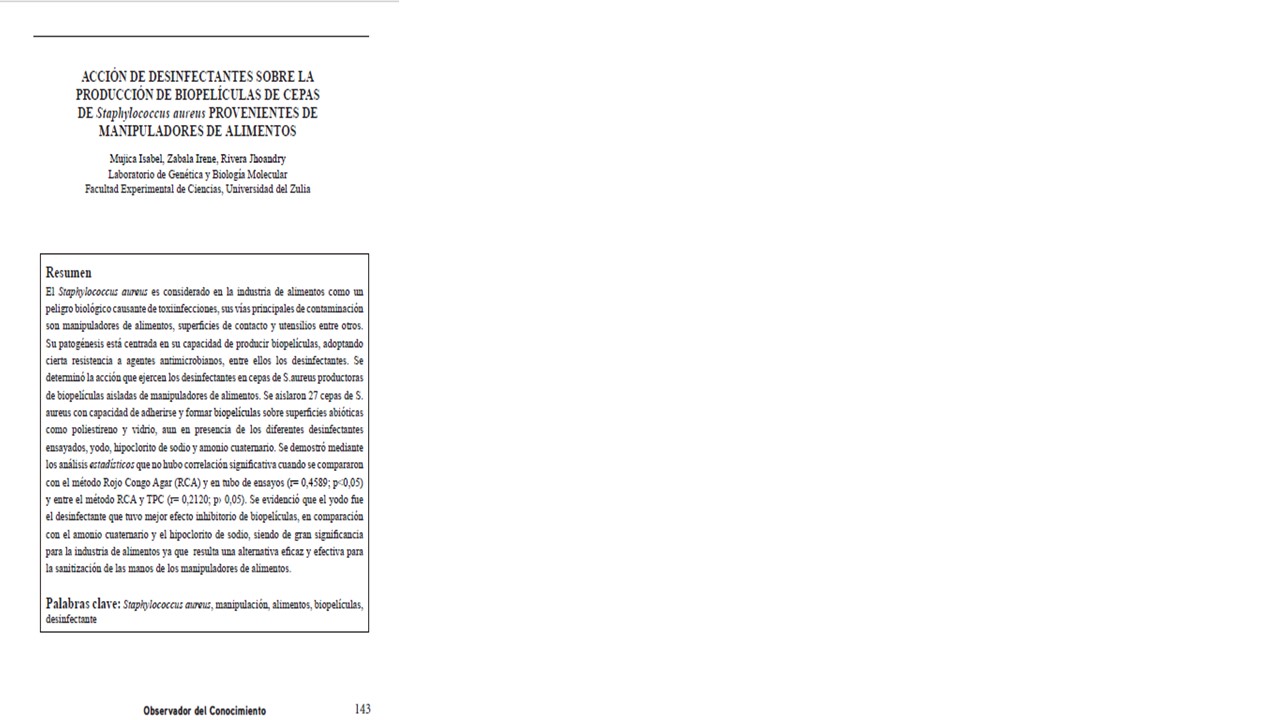Action of Disinfectants on the Production of Biopelicles of Cepas of Staphylococcus Aureus from Food Manipulators
Keywords:
Staphylococcus aureus, manipulation, food, biofilms, disinfectantAbstract
It was demonstrated by statistical analysis that there was no significant correlation when compared with the Congo Red Agar (RCA) method and in the test tube (r = 0.4589, p <0.05) and between the RCA and TPC method (r = 0.2120, p> 0.05). It was evidenced that iodine was the disinfectant that had the best inhibitory effect of biofilms, in comparison with quaternary ammonium and sodium hypochlorite, being of great significance for the food industry since it is an effective and effective alternative for the sanitization of hands of food handlers.
Downloads
References
Accoa, F.S.; Henriquesa, J.A.P.; Tondo, E.C. (2003). Identification of multiple strains of Staphylococcus aureus colonizing nasal mucosa of food handlers. Food Microbiology. 20: 489-
Arslan, S.; Ozcarde, F. (2007). Slime production and antibiotic susceptibility in Staphylococci isolated from clinical samples. Memória do Instituto Oswaldo Cruz. 102:29-33.
Christensen, G.; Simpson, W.; Younger, J.; Baddour, L.; Barrett, F.; Melton, D.; Beachey, E. (1985). Adherence of coagulase-negative staphylococci to plastic tissue culture plates: a quantitative model for the adherence of staphylococci to medical devices. Journal Clinical. Microbiology. 22:996-1006.
Figueroa, G.; Navarrete, P.; Caro, M.; Troncoso, M.; Faúndez, G. (2002). Portación de Staphylococcus aureus enterotoxigénicos en manipuladores de alimentos. Revista Médica de Chile. Versión impresa. ISSN 0034-9887. 130: 859-864.
Freeman, D.; Falkiner, F.; Keane, C. (1989). New method for detecting slime production by coagulase negative staphylococci. J. Clinical Pathology. 42:872-874.
González, J.A.; Rego, C. S.; Gallardo, F.J.; García, L.; Rodríguez, A. (2003). Efectividad de diferentes desinfectantes de uso alimentario frente a microorganismos aislados de una industria alimentaria. Alimentaria: Revista de tecnología e higiene de los alimentos. 341:49-52.
Greisen, K.; Loeffelholz, M.; Purohit, A.; Leong, D. (1994). PCR primers and probes for the 16S rRNA gene of most species of pathogenic bactéria, including bactéria found in cerebrospinal fluid. J. Clinical. Microbiology. 32:335-351.
Hacker, J.; Blum-Oehler, G.; Mulhdorfer, I.; Tschape, H. (1997). Pathogenicity islands of virulent bacteria: structure, function and impact on microbial evolution. Mol. Microbiol. 23:1089-109. Hacker, J.; Kaper, J. (2000). Pathogenicity islands and the evolution of microbes. Annu. Revista Microbiologia. 54:64- 679.
López, L.; Romero, J.; Ureta, F. (2002) Acción germicida in vitro de productos desinfectantes de uso en la industria de alimentos. Archivos Latinoamericanos de Nutrición. 52(1).
Lues, J.F.R.; Tonder, I. (2007). The occurrence of indicator bacteria on hands and aprons of food handlers in the delicatessen sections of a retail group. Food Control. 18: 326–332.
Mac Faddin, J. (2000). Biochemical test for identification of medical bacteria. chapter 19. Third Edition.United sate of America. Editorial Lawrence Mc Grew. Pp 254;272.
Manijeh, M.; Mohammad, J., Kermanshashi, K. (2008). The assessment of biofilm formation in Iranian meat processing environments. Res. Journal Micobiology. 3:181-186
Mejia,A; Morishita,T.Y.;Lam,K.M. (2004). The effects of seven chicken hatchery disinfectants on a Staphylococcus aureus strain. Preventive Veterinary Medicine.18:193-201.
Ramesh, A.; Padmapriya, B.; Varadaraj, A. (2002). Aplication of a convenient DNA extraction method and multiplex PCR for the direct detection of Staphylococcus aureus and Yersinia enterocolitica in Milk samples. Molecular and celular probes. 16:307- 314.
Rivera, J. (2009). Caracterización fenotípica y genotípica de cepas de Staphylococcus sp. Productoras de biofilm aisladas de quesos. Trabajo Especial de Grado. Facultad Experimental de Ciencias de la Universidad del Zulia. 80 pp.
Rodríguez, J.; Hernández, M. (2007). Importancia del control higiénico de superficies alimentarias mediante técnicas rápidas y tradicionales para evitar y/o minimizar la contaminación cruzada. Tesis Doctoral. Universidad Autónoma de Barcelona, España. 150 pp.
Tauxe, R. (2002). Emerging Foodborne pathogens. Internl. J. Food Microbiol. 78: 31-41.
Ubeda, C.; Tormo, M.A.; Cucarella, C.; Trotonda, P.; Foster, T.J.; Lasa, I.; Penades, J.R. (2003). Sip, an integrase protein with excision, circularization and integration activities, defines a new family of mobile Staphylococcus aureus pathogenicity islands. Mol. Microbiol. 49: 193-210.
Yazdani, R.; Oshagi, M.; Havayi, A.; Pishva, E.; Salehi, R.; Sadeghizadeh, M.; Foroohesh, H. (2006). Detection of icaAD gene and biofilm formation in Staphylococcus aureus isolates from wound infections. Iranian J. Publ. Health. 35:25-28.

Downloads
Published
How to Cite
Issue
Section
License

This work is licensed under a Creative Commons Attribution-NoDerivatives 4.0 International License.







